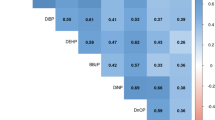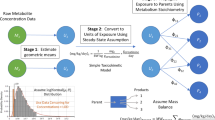Abstract
The creatinine correction approach has been used to estimate daily intake for contaminants whose primary route of elimination is through urine. This method is challenged using the phthalate di-2-ethylhexyl phthalate (DEHP) as an example. An alternate prediction approach based on human experimental metabolism and urinary excretion data on DEHP was developed. This alternate model was developed from urine measurements of four metabolites of DEHP from two individuals partaking in different experiments, for up to 44 h after known exposures. Particular attention was paid to the changing ratios of the metabolites over time: they took a certain form when exposure was in the “near” (the past few hours) versus the “distant” (24 h or more) past. The creatinine correction approach was applied to measurements of the same four metabolites from 18 individuals in the National Health And Nutrition Evaluation Survey (NHANES) 2003/2004. The alternate model was also applied to these individuals, and the results were compared. Predictions using the two methods were similar or the creatinine correction predicted higher concentrations when the ratio suggested that the DEHP exposure was “near” in time, but the alternate approach predicted intakes that were an order of magnitude higher when the ratios suggested that the intake was “distant”. As much as 25% of all NHANES measurements contain metabolites whose key ratio suggest that exposure was “distant”. Uncertainties notwithstanding, the analysis in this article suggests that the creatinine correction approach should be used cautiously for DEHP and possibly other contaminants with similar exposure characteristics: rapid metabolism with metabolite urine elimination half-lives on the order of hours, and exposure patterns that may not be continuous and ongoing.
This is a preview of subscription content, access via your institution
Access options
Subscribe to this journal
Receive 6 print issues and online access
$259.00 per year
only $43.17 per issue
Buy this article
- Purchase on Springer Link
- Instant access to full article PDF
Prices may be subject to local taxes which are calculated during checkout

Similar content being viewed by others
References
Barr D.B., Silva M.F., Kato K., Reidy J.A., Malek N.A., Hurtz D., Sadowski M., Needham L.L., and Calafat A.M. (2003) Assessing human exposure to phthalates using monoesters and their oxidized metabolites as biomarkers. Env Health Persp 111: 1148–1151.
Blount B.C., Valentin-Blasini L., Osterloh J.D., Mauldin J.P., and Pirkle J.L. (2007) Perchlorate exposure of the US population, 2001-2002. J Exp Sci and Env Epi 17: 400–407.
CDC. (2009). Fourth National Report on Human Exposure to Environmental Chemicals. Department of Health and Human Services, Centers for Disease Control and Prevention, National Center for Environmental Health, Division of Laboratory Sciences. Atlanta: Georgia, 30341–33724. Available for download at, http://www.cdc.gov/exposurereport/.
Cockcroft D.W., and Gault H. (1976) Prediction of creatinine clearance from serum creatinine. Nephron 16: 31–41.
David R.M. (2000) Exposure to phthalate esters. EHP 108: A440.
Fenske R.A., Kissel J.C., Lu C., Kalman D.A., Simcox N.J., Allen E.H., and Keifer M.C. (2000) Biologically based pesticide dose estimates for children in an agricultural community. Env Health Persp 108 (6): 515–520.
Franco A., Prevedouros K., Alli R., and Cousins I.T. (2007) Comparison and analysis of different approaches for estimating the human exposure to phthalate esters. Env Int 33: 283–291.
Koch H.M., Angerer J., Drexler H., Eckstein R., and Weisbach V. (2005a) Di(2-ethylhexyl)phthalate (DEHP) exposure of voluntary plasma and platelet donors. Int J Hyg Environ Health 208: 489–498.
Koch H.M., Bolt H.M., and Angerer J. (2004) Di(2-ethylhexyl)phthalate (DEHP) metabolites in human urine and serum after a single oral dose of deuterium labelled DEHP. Arch Toxicol 78: 123–130.
Koch H.M., Bolt H.M., Preuss R., and Angerer J. (2005b) New metabolites of di(2-3thylhexyl)phthalate (DEHP) in human urine and serum after single oral doses of deuterium-labelled DEHP. Arch Toxicol 79: 367–376.
Koch H.M., Bolt H.M., Preuss R., Eckstein R., Weisbach V., and Angerer J. (2005c) Intravenous exposure to di(2-ethylhexyl)phthalate (DEHP): metabolites of DEHP in urine a voluntary platelet donation. Arch Toxicol; DOI: 10.1007/s00204-1005-0004-s.
Kohn M.C., Parham F., Masten S.A., Portier C.J., Shelby M.D., Brock J.W., and Needham L.L. (2000) Human exposure estimates for phthalates. EHP 108: A440–A442.
Lorber M., Angerer J., and Koch H.M. (2010) A simple pharmacokinetic model to characterize exposure of Americans to di-2-ethylhexyl phthalate. J Expo Sci Env Epi 20: 38–53.
Mage D.T., Allen R.A., and Kodalia A. (2008) Creatinine corrections for estimating children's and adult's pesticide intake doses in equilibrium with urinary pesticide and creatinine concentrations. J Exp Sci Env Epi 18: 360–368.
Mage D.T., Allen R.H., Gondy G., Smith W., Barr D.B., and Needham L.L. (2004) Estimating pesticide dose from urinary pesticide concentration data by creatinine correction in the Third National Health and Nutrition Examination Survey (NHANES-III). J Exp Anal Env Epi 14: 457–465.
Marsee K., Woodruff T.J., Axelrad D.A., Calafat A.M., and Swan S.H. (2006) Estimated daily phthalate exposures in a population of mothers of male infants exhibiting reduced anogenital distance. Env Health Persp 114: 805–809.
Wittassek M., Heger W., Koch H.M., Becker K., Angerer J., and Kolossa-Gehring M. (2007a) Daily intake of di (2-ethylhexyl)phthalate (DEHP) by German children — a comparison of two estimation models based on urinary DEHP metabolite levels. Int J Hyg Environ Health 210: 35–42.
Wittassek M., Wiesmuller G.A., Koch H.M., Eckard R., Dobler L., Muller J., Angerer J., and Schluter C. (2007b) Internal phthalate exposure over the last two decades–A retrospective human biomonitoring study. Int J Hyg Environ Health 210: 319–333.
Wormuth M., Scheringer M., Vollenweider M., and Hungerbuhler K. (2006) What are the sources of exposure to eight frequently used phthalic acid esters in Europeans? Risk Analysis 26 (3): 803–824.
Author information
Authors and Affiliations
Corresponding author
Ethics declarations
Competing interests
The authors declare no conflict of interest.
Additional information
Disclaimer
The views expressed in this article are those of the authors and do not necessarily reflect the views or policies of the U.S. Environmental Protection Agency, the German Research Institute of Occupational Medicine, or the Friedrich-Alexander University of Erlangen-Nuremberg in Germany. Mention of trade names or commercial products does not constitute endorsement or recommendation for use.
Supplementary Information accompanies the paper on the Journal of Exposure Science and Environmental Epidemiology website
Supplementary information
Rights and permissions
About this article
Cite this article
Lorber, M., Koch, H. & Angerer, J. A critical evaluation of the creatinine correction approach: Can it underestimate intakes of phthalates? A case study with di-2-ethylhexyl phthalate. J Expo Sci Environ Epidemiol 21, 576–586 (2011). https://doi.org/10.1038/jes.2010.43
Received:
Accepted:
Published:
Issue Date:
DOI: https://doi.org/10.1038/jes.2010.43
Keywords
This article is cited by
-
Bisphenol A and phthalate metabolite urinary concentrations: Daily and across pregnancy variability
Journal of Exposure Science & Environmental Epidemiology (2015)
-
Metabolism of the plasticizer and phthalate substitute diisononyl-cyclohexane-1,2-dicarboxylate (DINCH®) in humans after single oral doses
Archives of Toxicology (2013)
-
Analytical methods for selected emerging contaminants in human matrices—a review
Analytical and Bioanalytical Chemistry (2012)
-
Di-n-butyl phthalate (DnBP) and diisobutyl phthalate (DiBP) metabolism in a human volunteer after single oral doses
Archives of Toxicology (2012)
-
Urinary DEHP metabolites and fasting time in NHANES
Journal of Exposure Science & Environmental Epidemiology (2011)



